“I told him that I was simply an ordinary citizen” – Witness Denies Involvement in Militia Activities
Today, witness Tay Kumhuon provided his testimony. The examination of this witness mainly revolved around establishing what tasks he was assigned with under the Khmer Rouge and where he was living at what time. He stated that he was mainly ploughing fields, while witness Seng Srun (see testimony of September 14 and 15) had stated that Tay Kumhuon had been a deputy commander of the so-called Long Sword group. Mr. Kumhuon stressed that he had been assigned to work at another location and therefore had only limited knowledge about events occurring in the village where Wat O Trakuon was located.
Places of Residence
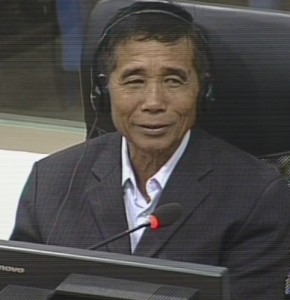
Witness Tay Kumhuon/Tay Kim Hoeun
At the beginning of the session, the Trial Chamber Greffier confirmed the presence of all parties with Nuon Chea participating from the holding cell. Today’s witness was 2-TCW-873, and reserve civil party 2-TCCP-252
Before the witness began his testimony, Mr. Koppe made oral submissions in relation to a request they had received from the Co-Prosecutors. The Co-Prosecutors had requested to call three more witnesses with regards to the treatment of the Cham.
One of the witnesses was someone who had testified in 2/01, and the two others had already testified as well.
At this point, Trial Chamber President Nil Nonn interrupted Mr. Koppe and stated that it would be better to hear these submissions in the afternoon. Mr. Koppe stated that he would request to stop the proceedings to give them more time to prepare, but that he could make this submission in the afternoon.
Tay Kumhuon was born in 1950 in Angkor Ban village, Angkor Ban commune. His wife was from Peam Chi Kan. He is a rice farmer and is father of two children, one of which died during the Khmer Rouge regime.
Wat O Trakuon as a Security Center
National Deputy Co-Prosecutor Srea Rattanak started the examination of the witness.
Before 1975, he lived in Angkor Ban Village. In 1972, he lived moved to Sambuor Meas Ka Village, Kang Meas district, Kampong Cham province where he continued living in 1975. He lived nearby the Wat O Trakuon Pagoda. His house is located around 50 meters from the compound of the pagoda. During the Khmer Rouge regime, it was transformed into a prison. He saw people being walked into the pagoda while he was having meal. The kitchen hall was next to the entrance of the pagoda. He saw this four to five times.
Asked about the time that he had meal, Mr. Kumhuon stated that he ate at 11.30. People were walked into the pagoda at that time. Sometimes he saw two people being walked into the pagoda, sometimes only one. He never saw a group of people being walked into the pagoda. They did not have means of transportation.
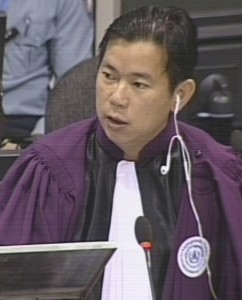
National Deputy Co-Prosecutor Srea Rattanak
To jog his memory, Mr. Rattanak referred to Mr. Kumhuon’s interview.[1] He had stated that prisoners were taken on a boat one time. Kumhuon denied this and stated that he did not see prisoners being taken off the boat. He usually ploughed the field in the forest. The people who were walked to the pagoda were tied up. There were also children and older people “in this group.” The children were not tied up. The three or four year old children were walking behind their parents. They were not tortured. Two people were in charge of leading the prisoners to the pagoda. He did not know whether they were New People. “I have never seen these people before.” He did not know why they were arrested. “I did not know what was going on at the time.” He did not know whether there were people to receive the prisoners, since he never went into the pagoda.
Mr. Rattanak then inquired whether he had heard music over loudspeakers, which Mr. Kumhuon confirmed.
It was not clear, however, whether he heard the music while he was at work, at home, or on his way home. He worked at night time from 6 pm until 10 pm. He first said that he heard the music when working, but then said that he heard it on his way home. He said that he heard the music sometimes at around 10 pm. His house was located to the East of the pagoda. Later he was transferred from his house and allowed to live one kilometer away. At that time that he heard music, he was living in the house that was one kilometer away.
Mr. Rattanak asked who told the witness that people were being killed. Mr. Kumhuon stated that co-workers told him so. Mr. Rattanak stated that “they said that perhaps people were being killed. That’s they were playing music”. He could hear the music being played once in a while. He heard different kinds of music being played.
Before the pagoda was turned into a Security Center, he would hear the monks’ prayers being played over the loudspeakers. He did not hear any other noises from the pagoda. Neither did he know where the people were put into the pagoda. He did not always see people being walked into the pagoda.
Mr. Rattanak then asked what happened to the people after having been walked into the pagoda, which the witness did not know. Mr. Rattanak then asked whether the music was being played the same day that Mr. Kumhuon saw people being walked into the pagoda. Mr. Koppe objected: according to him, Mr. Rattanak asked the questions with two presumptions. First, that people were being killed when loud music was being played. The second assumption was, Mr. Koppe argued, that people were being killed the same day. The Co-Prosecution should therefore refrain from asking repetitive questions.
Mr. Rattanak rephrased his question and referred to Mr. Kumhuon’s witness statement instead.[2]
The witness had stated that they were being killed in front of the pagoda. Mr. Rattanak asked how he knew this. At this point, National Khieu Samphan Defense Counsel Kong Sam Onn interjected. He stated that this question had no foundation, since Mr. Rattanak failed to ask general questions before.
Mr. Rattanak confronted the witness with his statement, where he had said that people were killed in front of the pagoda, whereas he stated now that he did not know what happened to prisoners after they entered the pagoda. Confronted with this contradiction, the witness said that he learned this after the end of the regime. Villagers went to see the grave pits. They told him that there were skeletons and clothes in these pits. He was told that these were “normal clothes.”
At this point, International Deputy Co-Prosecutor William Smith took the floor. He asked at what time Mr. Kumhuon went to the pagoda after the fall of the regime. He answered that he entered the pagoda compound “right in 1979” when the pagoda was being rebuilt. However, he did not look into the pits, since “the stench was rather strong.” Asked what the stench was like, Mr. Kumhuon replied that “it was the stench of corpses.”
Mr. Smith then inquired whether the witness knew a person called Chea Maly. Mr. Kumhuon confirmed that he knew this person and stated that he was a commune chief. Mr. Smith asked whether Chea Maly was a Buddhist monk. Mr. Kumhuon confirmed this. According to Mr. Kumhuon, Chea Maly had been disrobed. He left the pagoda after having been disrobed and lived with his family. He was forced to disrobe by the Khmer Rouge group.
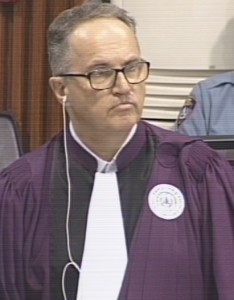
Deputy Co-Prosecutor William Smith
Mr. Smith then read an excerpt of a statement provided by Chea Maly.[3] This person had said that there were 100 to 150 pits. Some pits had five bodies; some others contained 50 to 100 bodies. According to Chea Maly’s statement, the pit size ranged from two times two meters and five times five meters. These pits had not been there when he left the pagoda in 1976. The remains that have been collected were only around a three/tenth of the bodies that were there.
Mr. Smith asked for a comment and whether this information was inaccurate or accurate.
At this point, Mr. Koppe objected and said that this was beyond Mr. Kumhuon knowledge. The objection was overruled.
Mr. Kumhuon answered that he did not know how many pits there were. He went to the pagoda to prepare religious ceremonies, but did not pay particular attention to the size of the graves.
At this point, the President adjourned the hearing for a break.
The Cham Population in Peam Chi Kan
After the break, Mr. Smith moved to the Cham population in Peam Chi Kan and Angkor Ban commune. He inquired whether there were Cham living in Peam Chi Kan and Angkor Ban communes when the Khmer Rouge took power. Mr. Kumhuon confirmed this. He did not know how many Cham were living in that commune. Mr. Smith asked whether it was correct that there were Cham brought into his village during the Khmer Rouge regime. Mr. Kumhuon confirmed this. He did not know where they came from. He did not know why they were brought to his village. Also people from Phnom Penh were brought into his village. He did not know about the number of families that had been brought in during Democratic Kampuchea. Cham people “were living normally as Khmer people were.” When Mr. Smith asked whether these people stayed in the village, Mr. Kumhuon stated that he did not know where the Cham were sent to, since he returned to his home village “every two or three months”. He was living in Koh Touch. The Cham were not longer there anymore in 1979 when the Khmer Rouge were defeated.
Mr. Smith then referred to an excerpt of Mr. Kumhuon’s testimony.[4] Mr. Kumhuon had replied to a question by the investigator that they arrested only the Cham people. Mr. Smith inquired whether this jogged the witness’s memory. Mr. Kumhuon answered that he never talked about the arrest of Cham people, since he did not know about this. He did not stay in his village.
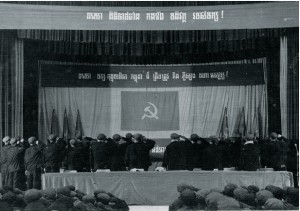
A communist Party of Kampuchea (CPK) conference (Documentation Center of Cambodia Archives).
Mr. Smith then inquired whether it was correct that he was living in Sambuor Meas Village most of the time from 1972 onwards. In his statement, he had said that he moved to Peam Chi Kan for around a year, where he would eat in the dining hall of Sambuor Meas Village A. Mr. Kumhuon replied that after the end of the regime, he was told that Pol Pot would come back to control the area. This is why he moved to Peam Chi Kan with his family after the fall of the regime in 1979. He did not stay in Peam Chi Kan. He was staying around seven kilometers away from the pagoda.
He never saw the arrests of Cham while working.
Mr. Smith then inquired about the assignment of “peddling water.” Mr. Kumhuon stated that no Cham were working in that field. Mr. Smith then referred to the witness’s Written Record of Interview.[5] Mr. Kumhuon had told the investigator that security personnel sometimes followed Cham and arrested them when the Cham went to peddle water. According to Mr. Kumhuon’s interview, these arrests occurred successively. Mr. Smith asked whether this statement was true. Mr. Kumhuon replied “I don’t think it’s completely correct. While I was ploughing the field, Cham people were arrested. At the time, they thought I was a Cham person. They pointed the weapons at my neck. At the time, they realized I was Khmer and went away. It was not during the time I was working at the field. It was at a worksite.”
Mr. Smith asked whether he saw the arrest of Cham, which Mr. Kumhuon confirmed. He saw that two or three Cham people were arrested. The Cham people were taken to plough the field. After they had been arrested, he saw them again. He did not know whether these Cham were alive today, since they had been arrested.
Mr. Smith read out an excerpt.[6] Mr. Kumhuon had said to the investigators that he saw hundreds of people being taken off a boat at meal time, including women, men, and children. At this point, Mr. Koppe interjected and read out the next sentence: the witness had not known whether Cham were in this group. The witness replied that he did not know whether people were taken from a boat.
The Long Sword Group
Mr. Smith asked whether he had worked in the Long Sword group during that period. Mr. Kumhuon replied that he was not a militiaman. He was assigned to plough fields. One day, soldiers collected him and pointed the gun at him. They asked him about his siblings. After this, he was assigned to harvest rice. He was neither in the militia group, nor the Long Sword group.
Mr. Smith then inquired whether Mr. Kumhuon had heard about the Long Sword group. Mr. Kumhuon stated that he had heard about it, but he did not know about the activities of this group. Mr. Smith pressed on and asked whether he was sure that he was never in the Long Sword group. Mr. Kumhuon confirmed this. Mr. Smith further asked whether he had no knowledge about the Long Sword group. Mr. Kumhuon stated that he did not know what the group did during the Khmer Rouge regime.
This prompted Mr. Smith to read out an excerpt of the witness’s statement.[7] The investigators had asked him about the Long Sword group. He had stated that he was part of the Long Sword unit. This unit had been divided into several sub-groups, including one security group that was responsible for arresting people. Some other teams ploughed the fields.
Mr. Smith asked whether this was the truth and whether Mr. Kumhuon knew about the Long Sword militia. Mr. Kumhuon replied that he was in the Long Sword unit. However, he was not involved in the activities of the group. He was tasked to guard the rice barn. He was not given any long sword.
In his interview he had told the investigators that Doeun was the direct superior in the long sword militia.[8] Mr. Smith asked whether this was correct. Mr. Kumhuon replied that he had only heard of Doeun but did not know how he looked like. He was not his superior. Doeun was at a different location.
Mr. Smith then referred to one of Seng Srun’s[9] interviews.[10] Seng Srun had stated that the chief of the Long Sword unit was Chay, his deputy being Tay Kim Hoeun.[11] Mr. Smith asked Mr. Kumhuon to comment on this. Mr. Kumhuon replied that he did not meet Srun, who was a soldier. Since then, he did not have any contact with him. Mr. Kumhuon stated that it was not true that he was a deputy leader of the Long Sword group, since he was not even a soldier. “Whatever he said is not correct.”
Mr. Smith then referred to another part of Seng Srun’s interviews, where he had stated that commune security chief Tay Kim Hoeun had ordered him to gather the Cham people and take them to the pagoda. According to Mr. Srun, Tay Kim Hoeun had told him that Cham people had to be smashed.[12] At this point, Khieu Samphan Defense Counsel Anta Guissé objected and stated that Seng Srun had provided a more recent testimony, which was different to what he had said before. Mr. Smith summarized the relevant parts of Mr. Srun’s testimony.[13]
Mr. Kumhuon denied that he had said to Seng Srun that Cham people had to be smashed.
Mr. Smith then inquired about the Long Sword in Peam Chi Kan commune and asked whether it was responsible for the arrests of Cham and other people. Mr. Kumhuon replied that he was not living in the village at the time and did therefore not know about the arrests of these people. With this, Mr. Smith finished his line of questioning and requested an extra ten minutes for the Civil Party lawyers, since he had taken more time than they had agreed amongst each other.
At this point, Civil Party lawyer Martine Jacquin took the floor. She asked the witness whether it was correct that he lived close to the pagoda. In his interview, he had stated that he lived in a house in an area which was not accessible to civilians, because he were a member of the security forces.[14] Ms. Jacquin asked to clarify the locations the witness had lived at. Mr. Kumhuon stated that he was asked to leave his home, since civilians were not permitted to enter this area.
Ms. Jacquin then inquired how many siblings were still alive today of the 25 family members he had indicated. She clarified that she was referring to the family members she had mentioned when being asked by the soldiers. He replied that some of them survived the regime.
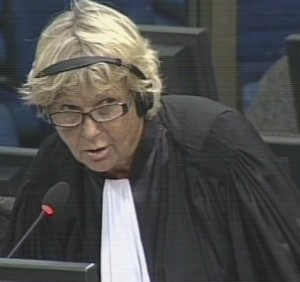
Civil Party Co-Lawyer Martine Jacquin
Ms. Jacquin asked whether it was correct that his life was “not very difficult given the political regime in place at the time”, given that he was 25 years old at the time and a Base Person. He rejected this: “My life was miserable living under the regime. The only food we ate was gruel, compounded by hard manual labor.”
She then inquired about his statement that his wife and child were crying when “they came to fetch you.” She asked why he was worried and how many people were called to represent the village. He did not know whether he was called to be part of the soldiers. Everybody knew that if someone was called to Wat O Trakuon, “their fate would be sealed there.”
Ms. Jacquin then referred to his interview, in which he had stated that he recognized his cousin who had been arrested.[15] He gave the names Thol, who was his adopted brother, and Lim Sron, who was his cousin. These were arrested with their families and children. Another cousin was called You Hao.
Mr. Kumhuon replied that he did not know what subsequently happened to them. He saw them being taken to the pagoda. He did not see them again. “It is very likely that they had been killed.”
She asked whether, when he saw a certain number of people enter the pagoda, he sometimes heard the children shout or play, which the witness denied.
At this point, the President adjourned the hearing for a break. The Civil Party Co-Lawyers would be granted ten minutes after the break.
Threatened by Soldiers
After the break, Ms. Jacquin returned to the point when he was taken away by soldiers. She asked whether he agreed that he was taken away to become a soldier at that time. “No, I was told I would become a soldier or a militiaman.”
She then inquired about the incident when two soldiers pointed their guns at him. He recounted that they pointed their guns at him, but people said that he was Khmer. “I was so afraid, I was even releasing myself in the field.” He was afraid of being taken as a Cham. Ms. Jacquin asked whether it was dangerous to be Cham. Mr. Kumhuon said that if he had been a Cham, he would have “been in the same situation as the Cham”.
Ms. Jacquin then inquired about the people who were taken to the pagoda and who had subsequently been killed. Mr. Kumhuon stated that this person was innocent. Ms. Jacquin asked why they were taken to the pagoda to be executed. The President instructed the witness not to answer this question. Ms. Jacquin queried whether he saw prisoners leaving the pagoda.
He said that he did not stay in his house anymore and was reassigned to work in the forest growing pumpkins and other vegetables. He would return to the cooperative once a month. Thus, he did not know whether they were released afterwards. He did not see any food supplies being brought into the pagoda.
When Ms. Jacquin asked whether he could have refused to join the Long Sword unit and what the consequences would have been if he had done so, Ms. Guissé objected to the second part of the question. The objection was sustained.
Ms. Jacquin then asked whether he had a choice to join the Long Sword group if he had been asked to join it. He answered that “I was staying close to that group […]. I was not included in that so-called Long Sword group.” He said that he would have died if he had refused to harvest rice.
Asked about his clothes, he said that he wore “normal clothes.” Sometimes he wore black clothes, and sometimes blue or light blue clothes.
He did not know whether Cham people had better living conditions than Khmer people before the Khmer Rouge arrived.
Ms. Jacquin stated that he must have been seen Cham people in his village, since they wore distinctive clothes. Ms. Guissé interjected and stated that Ms. Jacquin should have asked how Cham people could have been identified. Ms. Jacquin stated that she did not inquire about the clothes Cham people wore, but about the living conditions of Cham.
Mr. Kumhuon stated that there were no Cham people in his village before the Khmer Rouge arrived. They lived in another village. He did not know where the people who came to the village after the beginning of the Khmer Rouge regime came from. Since he did not organize the food supply, he was unable to tell anything about this.
This prompted Ms. Jacquin to ask why he was “so afraid” when the militiamen thought he was Cham. He said that he would have been killed if they had thought that he was Cham.
The people who were taken to the pagoda were Khmer. He did not know why his Khmer relatives were arrested.
At this point, Mr. Kong Sam Onn interjected and stated that the question was repetitive. He requested the President to intervene and end the Civil Party lawyer’s questioning, since she had been questioning for more than the extra ten minutes that had been granted to her. The President stated that Ms. Jacquin had exceeded the time granted to her and gave the floor to Judge Jean-Marc Lavergne.
Clarifications on Previous Issues
Judge Lavergne asked about two incidents when the witness had been threatened with weapons. He inquired at what location Mr. Kumhuon was threatened and mistaken for a Cham while working with Cham people. Mr. Kumhuon replied that this took place at Spean Au Kandal, where he was ploughing the field. Asked who was threatening with a gun, Mr. Kumhuon stated that he did not ask them where they were from. He was also not asking his co-workers who “came late behind him.” He was alone while he was threatened with the gun. Mr. Lavergne asked what happened to the Cham who were on the field with him. Mr. Kumhuon said that he left the place and did not know.
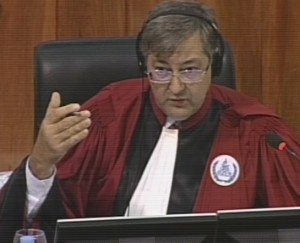
Judge Jean-Marc Lavergne
Next, Mr. Kumhuon told the court that the Cham were arrested after lunch after 12 pm. He could not recall which year this happened in. Judge Lavergne stated that the answers were inconsistent, since he had first stated that other people told the people threatening him with weapons that he was Khmer, and later said that he was alone on the field.
National Khieu Samphan Defense Counsel Kong Sam Onn interjected and stated that the summary given by Judge Lavergne was not appropriate, since the witness had said in Khmer that he himself shouted that he was Khmer when he was threatened.
Judge Lavergne asked what status the witness had at this point in time. Mr. Kumhuon stated that he was an ordinary citizen.
The distance between Sambuor Meas and Spean Au Kandal was between ten and 20 kilometers. At this time, his house was located in Sambuor Meas.
Judge Lavergne asked at what point in time the witness went to Peam Chi Kan. The witness replied that this was after 1979. During that period, they only stayed for a few nights. In 1977, they were relocated once. However, their new location was only around 700 meters away from his original residence. At present, he is living in Sambuor Meas village.
Judge Lavergne then turned to the second episode of being threatened by militia, at which they had tried to enlist him forcibly. Judge Lavergne inquired which version was the truth: that he was subsequently part of the Long Sword group, or not. Mr. Kumhuon stated that he stayed close to them for around two months. Then, he was “dissolved due to my not-so-good biography”, since around 20 members of his family had been killed. After these two months, he was sent to Kou Touch across the river.
He then said that he was standing guard at the rice field. Mr. Kumhuon stated that he was an ordinary civilian. He was withdrawn from guarding the rice barn at Koh Touch, but not from being a member of the Long Sword group.
When they pointed the guns at him and asked him to be a soldier, they asked him about his biography the next morning. After this, they “walked away.” They did not specify the tasks he would hold as a soldier. At this day, they “walked him to the commune and left me [there] over night.” The next day, they questioned him about his biography. They were from the Southwest. The person who questioned him was from the district. He did not know the commune chief of Peam Chi Kan at the time. Judge Lavergne asked whether he heard of the name Pheap, the wife of Kan. Mr. Kumhuon stated that he did hear these names, but never saw them.
Judge Lavergne then inquired whether it was correct that Mr. Kumhuon indeed only saw two or three arrests with two or three people each, accompanied by children. Mr. Kumhuon confirmed this.
He then asked “Were you bothered by nauseating smells?” when eating at the hall. Mr. Kumhuon denied this and stated that the dining hall was rather far away from the pagoda. To his estimation, this was around 400 to 500 meters. Judge Lavergne stated that he remembered that the witness had said this morning that the kitchen was only 50 meters away.
Judge Lavergne further asked about the witness statement, in which he had said that he saw prisoners that arrived with a boat. Mr. Kumhuon replied that he did not know about people being transported by boats.
This prompted Judge Lavergne to read out an excerpt of Mr. Kumhuon’s interview.[16] He had said that he saw prisoners being taken off the boat one time. According to his interview, he knew that they were prisoners because people talked about this in the dining hall. Judge Lavergne inquired whether these people were prisoners or people. Mr. Kumhuon replied that there were around 100 people and no security guards.
Judge Lavergne further inquired whether he knew any security guards, which the witness denied. He also did not know any person called Moeun.
At this point, Mr. Koppe was granted the floor to make an oral submission with regards to the Co-Prosecution’s submission E3/66. However, Mr. Koppe stated that it would be better to first finish the testimony, since he and the Khieu Samphan Defense Counsel did not have many questions.
Arrests of People in his District
Mr. Koppe took the floor and asked about Moeun again. Mr. Kumhuon stated that he did not know. Mr. Koppe then asked whether Seng Srun was also a palm tree climber. Mr. Kumhuon did not know and stated that he only knew him after the Khmer Rouge. Seng Srun “never stayed home, because he was a soldier.” Mr. Kumhuon stated that he did not know the role of Seng Srun during the Khmer Rouge, since he was ploughing the field.
Mr. Koppe then referred to his statement.[17] The witness had answered that the Wat O Trakuon pagoda was a security office and that people were not allowed to go there. This parameter extended to 700 or 800 meters around the pagoda. To the north of the pagoda, there was the river front, and to the South was the pond.
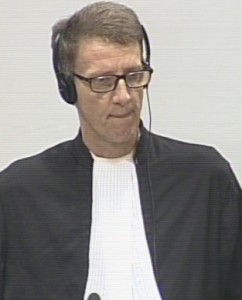
International Nuon Chea Defense Counsel Victor Koppe
Mr. Koppe then inquired about Mr. Kumhuon’s family members. Lim Sron was a new person. Hao was a base person. Thol was also a New Person. His aunt and uncle were base people. Hao was alone, Lim Sron was with eight children, Thol came with children, his aunt had six, and his uncle had seven children. None of these people were Cham.
They were arrested in Angkor Ban village. He did not know the reasons for their arrests.
Mr. Koppe then inquired whether it was true that arrests of whole families were nothing that was specific to Cham, but could also occur with Khmer families. Mr. Smith interjected, since the witness had stated that he did not know whether Khmer families had been arrested or not. Mr. Koppe replied that the Co-Prosecution’s presumption was that he had been a very active militiaman of the Long Sword unit. Based on his experience, the witness should answer the question. Mr. Smith answered that the witness had previously clearly stated that he did not know about arrests of Khmer families. The objection was overruled.
The witness answered that he had never seen the arrests of entire Khmer families. He was assigned to plough the fields on the other side of the river. Thus, he did not know about arrests.
Back to the Militia and Long Sword group
After the break, the floor was given to the Defense Team for Khieu Samphan. Anta Guissé asked about the security chief of the Peam Chi Kan. Mr. Kumhuon knew someone called Kan and Horn. He never met them. Horn was the chief of the Wat O Trakuon prison. He did not know anyone else who worked at the pagoda.
Ms. Guissé referred to his witness statement in which he had talked about the Long Sword group.[18] She inquired whether he remembered that there was a security unit in the Long Sword unit. Mr. Kumhuon stated that there was a security unit who worked at the pagoda. This unit was separate from the Long Sword unit. Ms. Guissé asked whether he remembered the names of other Long Sword group members from the time that he worked in the Long Sword group for two months. Ms. Guissé further inquired whether he knew someone called Lav Chay, which the witness denied. Neither did he know Meng Ly or Heng Pha. He knew someone called Yeun, but that person was not part of the Long Sword unit. He was a chief of a mobile unit. His full name is Ou Yeun.
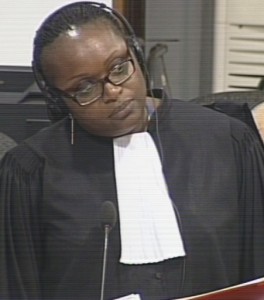
International Khieu Samphan Defense Counsel Anta Guissé
Ms. Guissé asked whether he heard someone speaking about the Long Sword unit while he was in this group for two months. Mr. Smith interjected and stated that he had clarified in today’s testimony that he was not a member of the long sword unit, but only worked close to them.
Mr. Kumhuon replied that he was not part of the Long Sword group. He was assigned to guard rice barns, after which he was assigned to work at Koh Touch.
He stated that the Long Sword group had stayed around 50 meters away from him. Ms. Guissé said that this distance would have enabled him to see members of this unit. Mr. Kumhuon stated that he did not dare looking at them, because he was afraid that he would be accused of trying to know about the nature of their work.
She referred to another witness’s statement who had stated that he had accompanied a group of Cham alongside the Long Sword group. Ms. Guissé asked whether Mr. Kumhuon knew that Mr. Srun had accompanied a group of Cham to the pagoda, since he had stated that he knew him. Mr. Kumhuon stated that he was unaware of this, since he stayed at Koh Touch.
In another part of the testimony, Mr. Seng Srun had stated that the Long Sword unit members were responsible for the arrests of people. Mr. Kumhuon stated that he did not see any member of the Long Sword unit arrest people. “I was unaware of whatever happened in the village.” He only made one boat trip every two months to receive his rice supplies.
Implications by Seng Srun
Ms. Guissé then asked about the part of the testimony where Mr. Kumhuon had indicated that he knew Tay Kim Hoern.[19] Mr. Kumhuon stated that he knew Seng Srun only after 1979. On September 15, Mr. Srun had stated that he “recognized Tay Kim Hoern” who brought the Cham. Mr. Kumhuon replied: “I categorically reject this statement.” He did not know the reasons why Mr. Sreng implicated him. Mr. Kumhuon then stated that he had been a pagoda committee member. According to Mr. Kumhuon, Seng Srun “did not get along well with the monks”, and built his own home at the pagoda land. He only recently helped around the pagoda.
Mr. Kumhuon then recounted how Seng Srun had told him that Mr. Srun had been summoned to court and asked him about his role during the Khmer Rouge regime. He had told him that after his biography had been taken, “I was drafted to be a soldier”, but did not become part of the militia. “I will go and talk to him when I come home from the court.”
Ms. Guissé read out parts of the testimony that Mr. Srun had provided. Again, Seng Sun had stated that Mr. Kim Huon was the deputy head of the long sword group. Mr. Kumhuon rejected this. “Maybe the reason was that one day a representative from this court came to ask me whether I was the security chief. “ He had clarified to this representative that the chief of the security was a person called Horn.
Ms. Guissé then referred to his discussion with the OCIJ was recorded, where he had stated that it was possible that his answers were not properly recorded. In his interview, he had speculated that perhaps, someone “wants to become a pagoda chief” – the position that he holds at the moment.[20] He recounted that Seng Srun had asked him whether he had been a security chief. “I told him that I was simply an ordinary citizen.” Someone had told Seng Srun that Kumhuon had been the security chief. “Seng Srun accused me on the matter blindly.”
Health conditions of the Witness
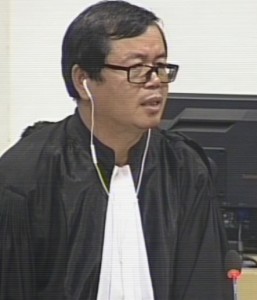
National Khieu Samphan Counsel Kong Sam Onn
At this point, Khieu Samphan Defense Counsel Kong Sam Onn took the floor. He asked what kind of disease the witness had before the interview of the investigating judges. Mr. Kumhuon had mentioned this before. He replied that he had been to the hospital and had been told that he had a “problem with the brain.” Currently, he takes medicine. When Mr. Sam Onn asked whether his disease had affected his memory, Mr. Smith interjected and stated that he had not heard the witness saying that he had a disease. “I tend to forget where I place my belongings. I have been weak from Pol Pot time.” He had recovered one month before the interview took place. He was still on medication at the time. His elder sibling read out his interview to him.
He was transferred out of his area in 1976.
Clarification on the Places of Residence
He left to work in a farm at Koh Touch in late 1977. He was living there until late 1979. In 1976 and 1977, he was assigned to plough the fields at Pdao. Sometimes, he was assigned to work at Au Kandal. He was assigned to work in different areas. When he was assigned to plough the fields, he was sleeping under the tree. He was assigned to work at vegetable farm, where he was sleeping in small huts. When he was reassigned to plough the fields within the cooperative, he was allowed to eat in the dining hall. He was assigned to plough the fields in the forest more often than to plough the fields near the dining hall.
He then asked how long he was staying in his village when visiting every two months. He stated that he had to return the same day.
Mr. Smith took the floor and asked the President to advise the witness not to confront Seng Srun with the testimony. This was a matter of witness protection for both parties. The President stated that the witness was “fully mature” and member of the pagoda committee. However,
“Please do not use any violence when you confront with another person – that is Mr. Seng Srun.”
After the witness had stated that he understood this matter, the President thanked the witness and dismissed him.
Next, the floor was given to Nuon Chea defense counsel Victor Koppe. Mr. Koppe stated that it might be better to make the submissions tomorrow morning. Two requests for clarification, one request with broader impacts.
The President adjourned the hearing. Tomorrow, the testimony of a Civil Party 2-TCCP-252 will be heard.
[1] E3/5257, at 00243103 (KH), 00342666 (FR), 00251016 (EN). [2] E3/5257, at 00243107 (KH) 00251021 (EN) 00342672 (FR). [3] E3/7827, at 00210432-33 (EN). [4] E3/5257, at 00251019 (EN), 00243106 (KH), 00342671 (FR) [5] E3/5257, at 00251019-20, 00243106 (KH), 00342671 (FR). [6] E3/5257, at 00251016 (EN), 00243102-03 (KH), 00342667 (FR). [7] E3/5257, 00251018 (EN), 00243104-05 (KH), 00342669 (FR). [8] E3/5257, at 00251018-19, 00243105 (KH), 00342670 (FR). [9] Seng Srun had testified in front of the court on Monday, September 14. [10] E3/5252, at 00235517 (EN), 00235021 (KH), 00269891 (FR) [11] Different spellings exist: it had also been spelled Tay Kim Horn. [12] E3/5302, at 00210488 (EN), 00635176 (KH), 00623191-92 (FR) [13] See post of September 14, 2015. [14] E3/5257, at 00242102 (KH), 00251015-16 (EN), 00342665 (FR). [15] E3/5257, at 00243101 (KH), 00251014 (EN), 00342663 (FR) [16] E3/5257, at 00342666-67 (FR), 00251016 (EN), 00243105 (KH). [17]E3/5257, at 00251015 (EN), 00342665 (FR), 00243101 (KH)..# [18] E3/5257, at 00342669 (FR), 00243104 (KH), 00251018 (EN) [19] Transcript of Testimony of Seng Srun, September 14 2015, at 14h22. [20] D166/42.1, at 001142460 (FR), 00114831 (KH), no English translation available.
